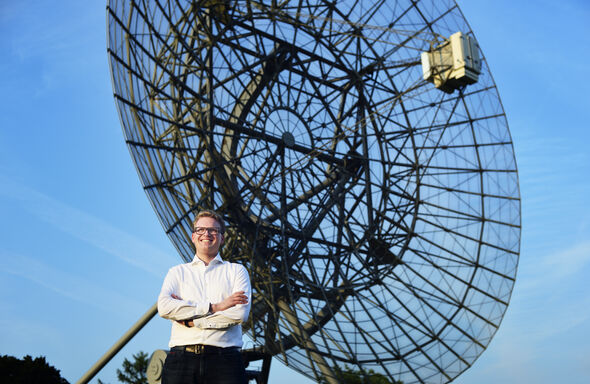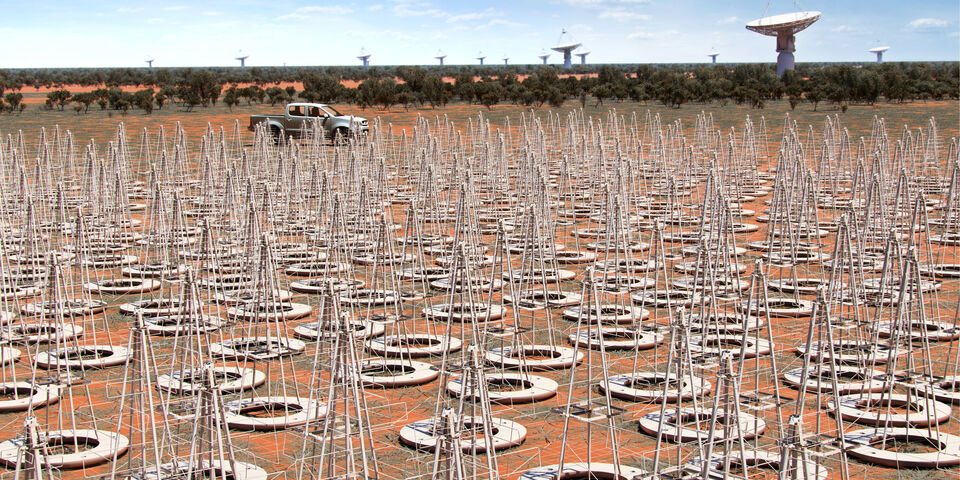A glance at infinity
The Square Kilometre Array (SKA), a gigantic radio telescope that is being built in South Africa and Australia, promises to be the largest scientific instrument in the world. The processing of the SKA’s unparalleled data flows calls for the most efficient supercomputer conceivable. In the Drenthe village of Dwingeloo, the heart of Dutch radio astronomy, PhD candidate Rik Jongerius investigated what would be the best way to go about this.
In the next four years 133 dishes each 15 meters in diameter will arise in the South African desert and more than 100,000 antennas will be installed in the Australian outback. Together these structures will form the first stage of the Square Kilometre Array (SKA), the world’s largest radio telescope. And that is just the beginning; in the end some 2,000 dishes have been provided for, arranged along spiral arms with a width of hundreds of kilometers, and a million antennas, ranging from several dozens of centimeters to some 1.5 meters in height.
Together all these radio receivers will command an unparalleled view of the distant past of the universe, more than thirteen billion years ago; indeed, the SKA telescope (budget for the first stage alone: 650 million euros) must be sensitive enough to detect radiation from the first billion years after the Big Bang, the period in which the first stars were formed. Astronomers and cosmologists hope to learn from this how stars and galaxies are born, what is the nature of the mysterious dark matter and energy, and perhaps even if there is any extraterrestrial life.
It takes a supercomputer with the computing power of one hundred million PCs
The processing of all the measurement data of the SKA telescope (no less than ten times the worldwide Internet traffic) takes a supercomputer with the computing power of one hundred million PCs: it can make as many as an astronomic billion billion (1018) calculations per second. Such a computer does consume a fair amount of power, as PhD candidate Rik Jongerius explains. “Of course, that power is not just readily available in the desert, and let’s not forget about the costs involved.” For that reason the alumnus of the TU/e program of Electrical Engineering investigated how the energy consumption of the required computer system can be kept as low as possible.
Both SKA and its precursor LOFAR (a series of antenna arrays with Drenthe as the center, but extending to stations in Great Britain, Sweden and Poland) are used for electronically combining measurements at the numerous antennas, which makes it possible in practice to achieve a measuring sensitivity and accuracy commensurate with those of a much larger dish. SKA owes its name to that principle: the Square Kilometre Array will form the equivalent of a dish with a surface or more than one square kilometer.
In short, we are talking about a gigantic detector which will spit out a similarly gigantic flow of measurement data. Out of necessity the data flow of the mega telescope will therefore be reduced real-time: only the relevant data will be stored for later analysis. It was up to Jongerius to analyze how the requisite software behaves on different processor architectures.
In the original design proposed by SKA the energy consumption in 2018 would boil down to some 120 megawatt, as the analysis showed. That matches a quarter of the consumption of a coal-fired power station - which is unacceptable, according to Jongerius. “In part on the basis of my findings it has consequently been decided to start on a more modest scale. That brings us to 30 megawatt with today’s technology, but we should be able to make it significantly more economical. In the end a small solar power plant should be enough for the first stage.”



Discussion